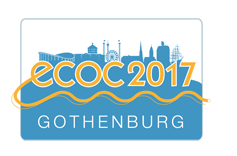WORKSHOPS
Opportunities for machine learning in optical communication: from components characterisation, systems design and network optimisation
Sunday 14:00-18:00
Orginisers:
Darko Zibar, DTU Fotonik, Technical University of Denmark
Henk Wymeersch, Chalmers University of Technology, Sweden
Ilya Lyubomirsky, Inphi, USA
Abstract:
In broad terms, machine learning is a multidisciplinary research area where some of the main tasks are to infer plausible models to describe the observed data and use the inferred models to make predictions. The core of the machine learning approaches is generalization: first the model is learned from the measured data acquired under one set of system configurations, and then the inferred model is applied to perform predictions for a new set of system configurations. Machine learning is especially useful for optimization and performance prediction for systems that exhibit complex behaviors and where analytical model are hard to derive and numerical procedures time consuming. Recently, machine learning methods have started to enter the field of photonics, ranging from quantum mechanics, nanophotonics, optical communication and optical networks. Moreover, a few optical implementations of some machine learning algorithms have also been proposed recently.
The field of machine learning offers many powerful techniques, however, linking it to optical communication and photonics in general may not be trivial. In particular, choosing the right machine learning algorithm strongly depends on the problem that needs to be solved. In this workshop, we will address how techniques from machine learning can be applied in the field of optical communication and photonics, and which benefits machine learning methods can bring to optical communication. We will explore how machine learning can be used to design better lasers, predict the performance of optical communication systems, perform nonlinearity mitigation, optimize data centers and enable intelligent test & measurement equipment for next generation of optical networks. Moreover, we will look into how all-optical signal processing and integrated photonics can benefit the field of machine learning and which novel research opportunities could arise for all-optical solutions.
14.00-14:05; Darko Zibar, DTU Fotonik, Denmark “Introduction to part I: ML for physical layer”
14:05-14:25; Thomas Schon, Uppsala University, Sweden, “Machine learning: trends and perspectives”
14:25-14:35; Hansjoerg Haisch, Keysight Technologies, Germany “Data analytics for measurement equipment”
14:35-14:45; Takahito Tanimura, Fujitsu Labs, Japan “Deep learning in optical performance monitoring”
14:45-14:55; Alan P. T. Lau, Hong Kong Polytechnic University, China “Application of machine learning to optical performance monitoring”
14:55- 15:05; Jakob Thrane, MLytico, Denmark “Machine learning methods for system performance prediction”
15:05-15:15; Christian Schaeffer, Helmut Schmidt University, Hamburg, Germany “Application of ML in coherent quantum receivers”
15:15-15:25; Seb Savory, Cambridge University, UK “Machine learning: transceivers to networks”
15:25-15:45; Panel discussion: what have we learned from part I and what are the future prospects
15:45-15:55; Coffee Break
15:55-16:00; Henk Wymeersch, Chalmers University of Technology, Sweden “Introduction to part II: ML for networking layer”
16:00-16:10; Danish Rafique, ADVA, Germany “Data Analytics based Network Operation and Management infrastructure”
16:10-16:20; Cristina Rottondi, Dalle Molle Institute for Artificial Intelligence, Switzerland “Machine learning-assisted routing and spectrum assignment in flexible optical networks”
16:20-16:30; Luis Velasco, Universitat Politècnica de Catalunya, Spain “A distributed data analytics architecture for cognitive transport networks”
16:30-16:40; Naga V. Irukulapati, Ericsson, Sweden “The need for machine learning and data analytic for future communication infrastructure”
16:40-16:45; Ilya Lyubomirsky, Inphi, USA “Introduction to part III: non-telecom applications of ML in optics”
16:45-16:55; Peter Bienstman, Ghent University, Belgium “Integrated-photonics implementation of reservoir computing neural networks”
16:55-17:05; Satyajeet Sing Ahula, Facebook, USA “Applications of machine learning in Facebook’s production network”
17:05-17:15; Radha Nagarajan, Inphi, Sweden “LIDAR DSP and sensor fusion based on deep neural networks”
17:15-17:25; Nasser Mohammadiha, Zenuty, Sweden “Machine Learning for autonomous driving”
17.25-18.00 Panel discussion: what have we learned from part II-III and what are the future prospects

